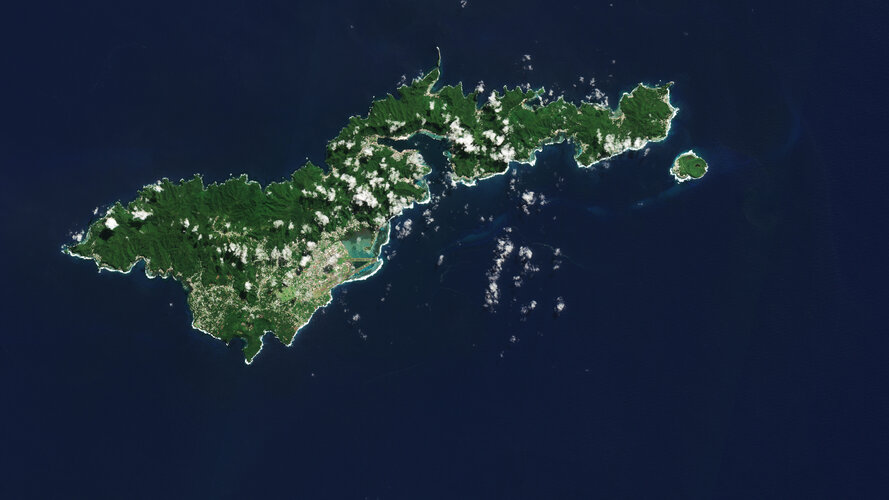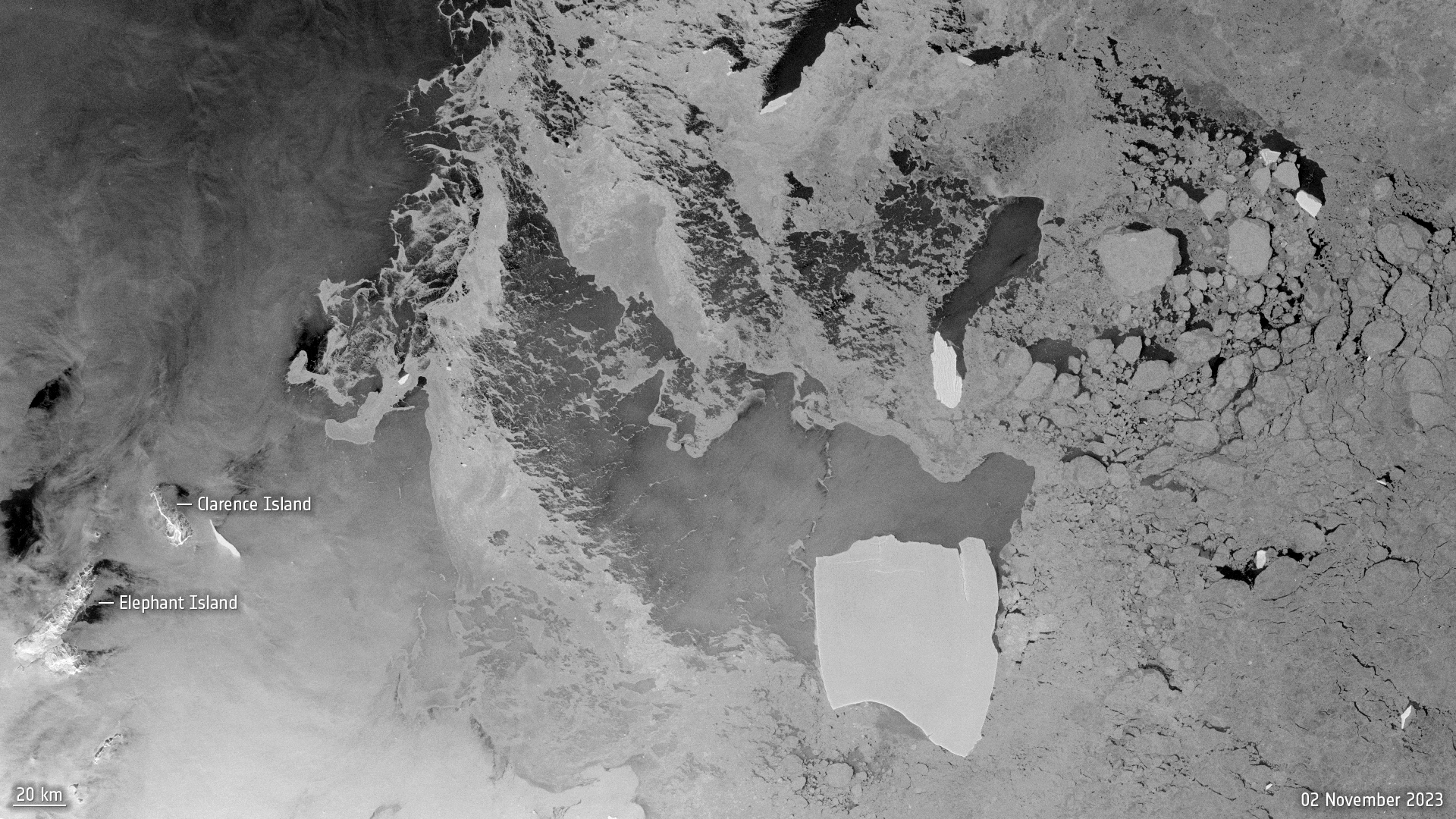
Copernical Team
Prometheus prototype engine test
 Video:
00:00:24
Video:
00:00:24
Scenes from a 30-second burn with re-ignition of an early prototype of the Prometheus engine at ArianeGroup’s test facility in Vernon, France, on 20 October 2023.
The 100-tonne thrust class Prometheus burns liquid oxygen-liquid methane fuel. Methane is clean burning and simplifies handling, to help enable reusability and reduce the cost of ground operations before and after flight.
The engine is mounted in an early prototype of a reusable rocket stage, called Themis, which is being developed in parallel with the engine under contract from ESA. While engine testing continues, work is also underway to prepare a more advanced
New images of rare thunder
ESA astronaut Andreas Mogensen has captured images of rare thunder phenomena as part of the Thor-Davis experiment on his Huginn mission.
Earth from Space: American Samoa
 Image:
The Copernicus Sentinel-2 mission shows us an amazing view of the tropical island of Tutuila, the largest in the American Samoa archipelago in the South Pacific Ocean.
Image:
The Copernicus Sentinel-2 mission shows us an amazing view of the tropical island of Tutuila, the largest in the American Samoa archipelago in the South Pacific Ocean. NASA's Educational CubeSats: Small Satellites, Big Impact
 Despite their small size, the satellites launching through NASA's CubeSat Launch Initiative (CSLI) missions have a big impact, creating access to space for many who might not otherwise have the opportunity. One recent mission tells the story of four teams of researchers and engineers who conceived, built, launched, and collected data from these shoebox-sized satellites, helping them answer a hos
Despite their small size, the satellites launching through NASA's CubeSat Launch Initiative (CSLI) missions have a big impact, creating access to space for many who might not otherwise have the opportunity. One recent mission tells the story of four teams of researchers and engineers who conceived, built, launched, and collected data from these shoebox-sized satellites, helping them answer a hos NASA shuttle astronaut, scientist Mary Cleave remembered as 'trailblazer'
 NASA on Thursday paid tribute to retired astronaut Mary Cleave, the first woman associate administrator for NASA's Science Mission Directorate, who died Nov. 27 at 76.
Cleave, a veteran of two NASA spaceflights, became an astronaut in 1980.
"I'm sad we've lost trailblazer Dr. Mary Cleave, shuttle astronaut, veteran of two spaceflights, and first woman to lead the Science Mission
NASA on Thursday paid tribute to retired astronaut Mary Cleave, the first woman associate administrator for NASA's Science Mission Directorate, who died Nov. 27 at 76.
Cleave, a veteran of two NASA spaceflights, became an astronaut in 1980.
"I'm sad we've lost trailblazer Dr. Mary Cleave, shuttle astronaut, veteran of two spaceflights, and first woman to lead the Science Mission A spectrum of possibilities: insights into the evolution of far-red light photosynthesis
 A collaborative study led by Dr. Christopher Gisriel at Yale University and Dr. Tanai Cardona at Queen Mary University of London, published in Frontiers in Plant Science, offers new insight on the origin and evolution of a unique type of photosynthesis that enables some bacteria, specifically cyanobacteria, to harness far-red light.
Far-red light, which falls between 700 to 800 nanometers
A collaborative study led by Dr. Christopher Gisriel at Yale University and Dr. Tanai Cardona at Queen Mary University of London, published in Frontiers in Plant Science, offers new insight on the origin and evolution of a unique type of photosynthesis that enables some bacteria, specifically cyanobacteria, to harness far-red light.
Far-red light, which falls between 700 to 800 nanometers Globalsat enhances connectivity across Latin America with Rivada's OuterNET
 Globalsat Group, a provider of mission-critical satellite and wireless connectivity solutions, has announced a strategic partnership with Rivada Space Networks to deploy the OuterNET, a next-generation data network, across Latin America. This collaboration is set to revolutionize connectivity for customers in key sectors such as energy, government, NGOs, agriculture, utilities, and transportatio
Globalsat Group, a provider of mission-critical satellite and wireless connectivity solutions, has announced a strategic partnership with Rivada Space Networks to deploy the OuterNET, a next-generation data network, across Latin America. This collaboration is set to revolutionize connectivity for customers in key sectors such as energy, government, NGOs, agriculture, utilities, and transportatio Arcus: Collins Aerospace's novel training image generator revolutionizes aircrew simulation
 Collins Aerospace, a business unit of Raytheon Technologies Corporation (NYSE: RTX), has announced the release of its latest innovation, Arcus, an image generator designed to significantly enhance aircrew training. This new technology uniquely integrates advanced rendering tools developed by Collins with the dynamic gaming technology of Epic Games' Unreal Engine, promising a more immersive and m
Collins Aerospace, a business unit of Raytheon Technologies Corporation (NYSE: RTX), has announced the release of its latest innovation, Arcus, an image generator designed to significantly enhance aircrew training. This new technology uniquely integrates advanced rendering tools developed by Collins with the dynamic gaming technology of Epic Games' Unreal Engine, promising a more immersive and m Direct-to-phone satellite connectivity emerging as major new market this decade
 Paris, France (SPX) Dec 01, 2023
The Mobile Satellite Services (MSS) industry is currently witnessing a pivotal transformation, as highlighted in the latest edition of Euroconsult's 'Prospects for Direct to Handheld and IoT Markets'. This transformative shift is primarily attributed to the emergence of direct-to-device satellite solutions, particularly direct-to-phone services. These advancemen
Paris, France (SPX) Dec 01, 2023
The Mobile Satellite Services (MSS) industry is currently witnessing a pivotal transformation, as highlighted in the latest edition of Euroconsult's 'Prospects for Direct to Handheld and IoT Markets'. This transformative shift is primarily attributed to the emergence of direct-to-device satellite solutions, particularly direct-to-phone services. These advancemen Iceberg on the loose
 Image:
After being grounded on the ocean floor for well over four decades, the largest iceberg in the world is on the loose.
Image:
After being grounded on the ocean floor for well over four decades, the largest iceberg in the world is on the loose. 
